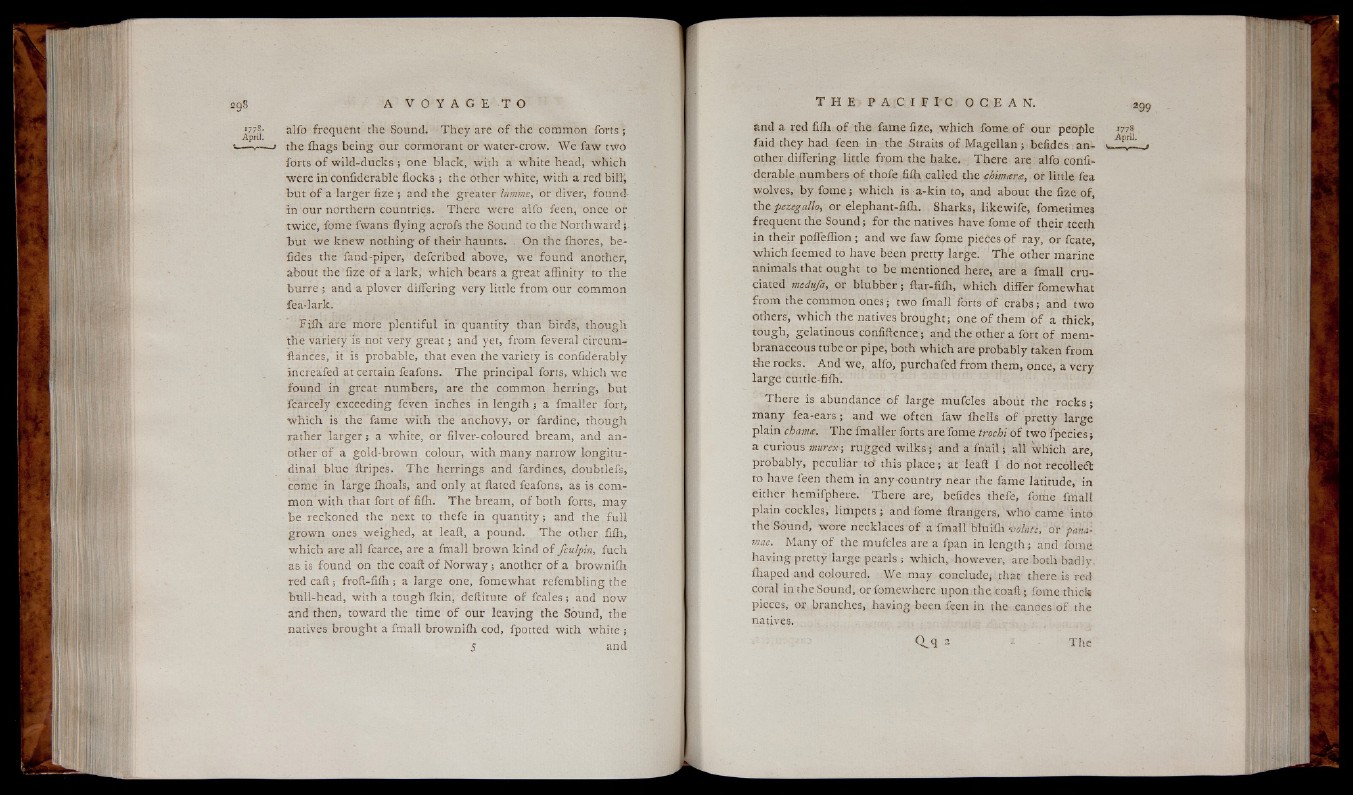
alfo frequent the Sound. T h e y are o f the common fo r ts ;
the ihags being our cormorant or water-crow. We faw two
forts o f wild-ducks ; one black, with a white head, w hich
were in confiderable flocks ; the other white, with a red bill,
b u t o f a larger fize ; and the greater himme, or diver, fourid-
in our northern countries. There were alfo feen, once or
twice, fome fwans flying acrofs the Sound to the Northward;
b u t we kn ew nothing o f their haunts. . On the fhores, be-
fides the fand-piper, defcribed above, w e found another,
about the fize o f a lark, which bears a great affinity to the
burre ; and a plover differing very little from our common
fea-lark.
Fffh are more plentiful in quantity than birds, though
the variety ‘is hot ve ry g r e a t ; and yet, from feveral circum-
flances, it is probable, that even the variety is confiderably
increafed at certain feafons. T he principal forts, which w e
found in great numbers, are the common herring, but
fcarcely exceeding feven inches’ in length •, a fmaller fort,
w h ich is the fame with the anchovy, or fardine, though
rather la r g e r ; a white, or filver-coloured bream, and another
o f a gold-brown colour, with many narrow long itu dinal
b lu e ftripes. T h e herrings and fardines, doubtlefs,
come in large ihoals, and only at ftated feafons, as is common
w ith that fort o f fifh. T h e bream, o f both forts, may
be reckoned the next to thefe in q u a n tity ; and the fu ll
grown ones weighed, at leaft, a pound. The other fifh,
which are all fcarce, are a fmall brown kind o f fculpin, fuch
as is found on the coaft o f Norway ; another o f a brownifh
red c a ft ; fro it-fiih ; a large one, fomewhat refembling the
bull-head, with a tough fkihj deflitute o f fc a le s ; and now
and then, toward the time o f our leaving the Sound, the
natives brought a fmall brownifh cod, fpotted with w h i t e ;
5 and
and a red fifh o f the fame fize, w hich fome o f our people
faid they had feen in the Straits o f Magellan ; befides : an- s,,^ - j
other differing little from the hake, The re are alfo confiderable
numbers o f thofe fifh called the chimxrs, or little fea
wolves, by fom e ; w hich is a -kin to, and about the fize of,
the pezegallo, or elephant-fiih. Sharks, likewife , fometimes
frequent the Sound; fo r the natives have fome o f their teeth
in their poffeffion ; and we faw fome pieces o f ray, or fcate,
which feemed to have been pretty large. T h e other marine
animals that ought to be mentioned here, are a fmall cru-
ciated medufa, or b lu b b e r ; ftar-fifh, which differ fomewhat
from the common ones; two fmall forts o f crabs; and two
others, which the natives brought; one o f them o f a thick,
tough, gelatinous confiftence; and the other a fort o f membranaceous
tube or pipe, both w hich are probably taken from
t-he rocks. And we, alfo, purchafed from them, once, a very
large cuttle-fifh.
The re is abundance o f large mufcles about the r o c k s ;
many fea-ears ; and we often faw ihells o f pretty large
plain chatms. T he fmaller forts are fome trochi o f two fpecies;
a curious murex-, ru gg ed w ilk s ; and a fn'ail; all which are,
probably, peculiar to* this p la c e ; at lead I do riot recoiled*
to have feen them in any-country near the fame latitude, in
either hemifphere. There are, befides thefe, fome fmall
plain cockles, lim p e ts ; and fome ftrangers, who came into
the Sound, wore necklaces o f a fmall blu iih kiolute, or pana-,
mae. Many o f the mufcles are a fpan in length ; and fome
h a vin g pretty large pearls; which, however, are both badly,
iliaped and coloured. We may conclude; chat there is red
coral in the Sound, orfomewhere upon the co a ft; fome thick
pieces, or branches, having been feen in the canoes o f the
natives.